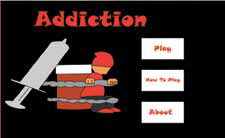ALL PLAY AND NO WORK

According to conservative estimates, kids will play more than 10,000 hours of games by the time they graduate from high school. This has inspired a growing movement in schools to use games, also known as “participatory media,” as motivational teaching tools.
GAMES WITH PURPOSE
In a student-centered game design program at East Austin College Prep in Texas, middle school learners begin their game-making process by choosing a social issue about which they are passionate. This will become the subject of a semester-long research project and culminate in an educational Web game to be shared with the world. All middle school students at the school take a game design class called “Globaloria,” which combines a social media platform and curriculum used by schools in several states. This is made possible through funding from AMD Foundation’s Changing the Game program.
You can play Addiction at: www.myglife.org/usa/eaprepmlk/index.php/Special:GlobaloriaGamesGallery/192
Students express their passion and ideas through their game content and game play. Aaron, a 7th-grade student, chose to make a game about teen drug abuse, entitled “Addiction.” He describes his process: “I researched one of the most popular drugs that teens use and looked at what different drugs do to the body. Then I made obstacles in the game for characters to get away from drugs.” Instead of focusing on facts, Aaron’s game is a Mario Brothers-like experience where players move through different levels, making life choices along the way.
TEACHING GAMING
Students find ways to express their ideas in code and they also develop vital 21st-century skills. Learning to code—whether the tool is Scratch, Flash, Game Maker, or any other tool—is an essential part of the game-making equation. Teachers do not need to be computer programmers to guide kids in learning how to code. When teachers learn alongside their students, this creates a very supportive model. Teresa Valdez teaches 7th- and 8th-grade game designers. She says: “It helps to not be an expert because you can share your steps to figuring out [the process] in real time. In programming, there is not always one way to solve the problem, so I try to give kids a mental check list they can go through that will lead them to a solution.”
Tools and ideas to transform education. Sign up below.
TECH SUPPORT FOR PARTICIPATORY MEDIA
Using a wiki collaboration space, game-designing students develop collaboration skills beyond typical group work. By using a wiki, Eighth-grade teacher Nyssa Arcos’ students in Texas learn to collaborate not only across classes and geography, but also by serving as mentors to a younger group of game designers in northern California. Her students guide their mentees by posting comments on their project pages and occasionally sending messages to check in.
Laura Minnigerode is an educator and education policy researcher based in Austin, TX.
